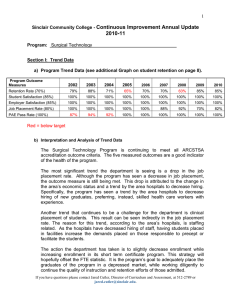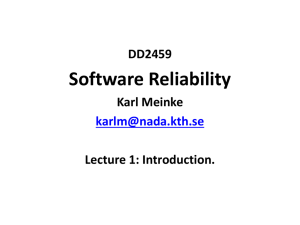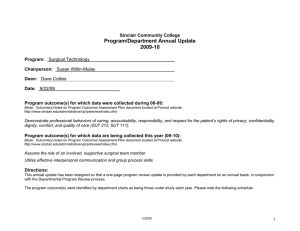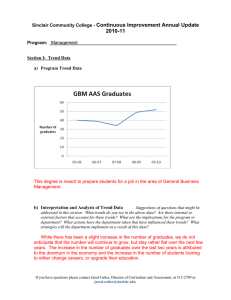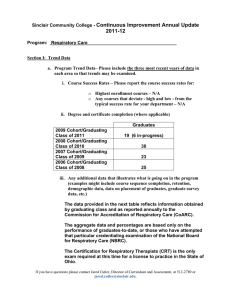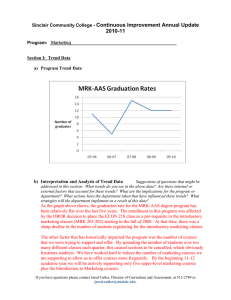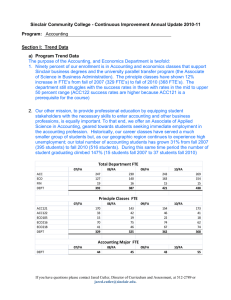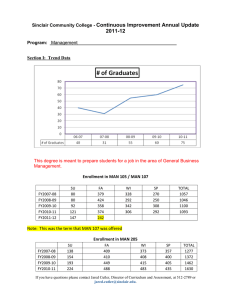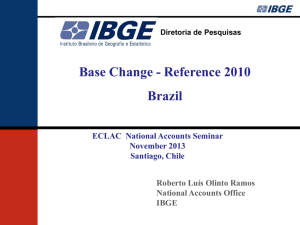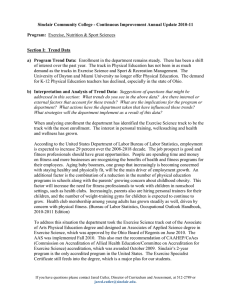Sinclair Community College - Continuous Improvement Annual Update 2011-12 Program:
advertisement
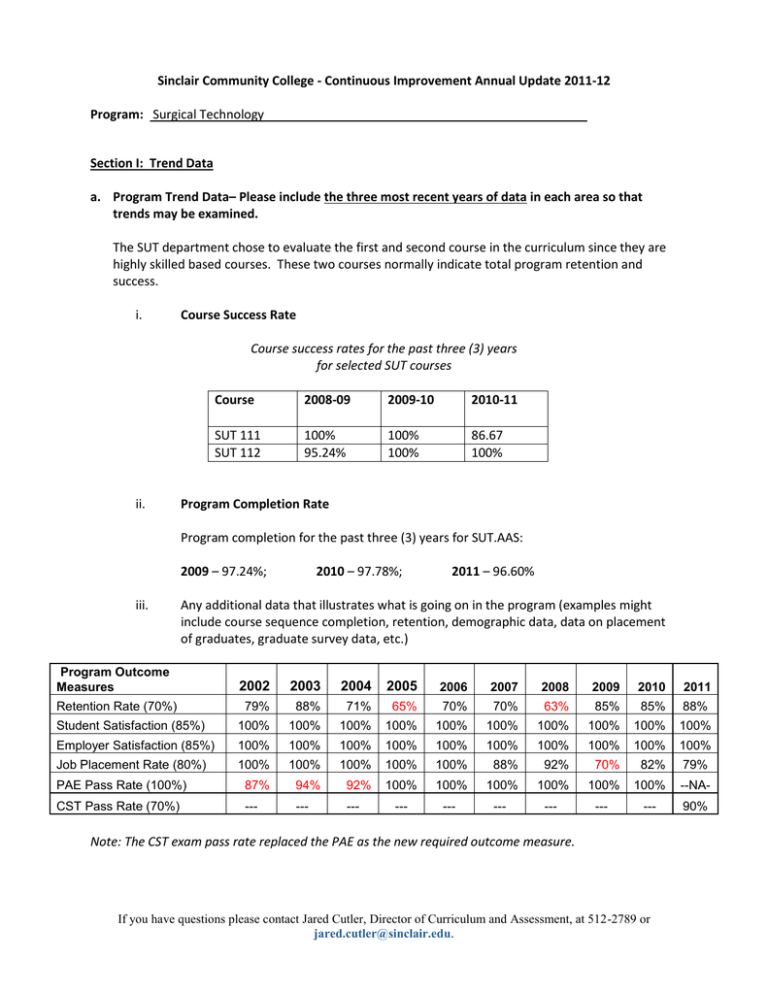
Sinclair Community College - Continuous Improvement Annual Update 2011-12 Program: Surgical Technology Section I: Trend Data a. Program Trend Data– Please include the three most recent years of data in each area so that trends may be examined. The SUT department chose to evaluate the first and second course in the curriculum since they are highly skilled based courses. These two courses normally indicate total program retention and success. i. Course Success Rate Course success rates for the past three (3) years for selected SUT courses ii. Course 2008-09 2009-10 2010-11 SUT 111 SUT 112 100% 95.24% 100% 100% 86.67 100% Program Completion Rate Program completion for the past three (3) years for SUT.AAS: 2009 – 97.24%; iii. 2010 – 97.78%; 2011 – 96.60% Any additional data that illustrates what is going on in the program (examples might include course sequence completion, retention, demographic data, data on placement of graduates, graduate survey data, etc.) Program Outcome Measures 2002 2003 2004 2005 2006 2007 2008 2009 2010 2011 Retention Rate (70%) 79% 88% 71% 65% 70% 70% 63% 85% 85% 88% Student Satisfaction (85%) 100% 100% 100% 100% 100% 100% 100% 100% 100% 100% Employer Satisfaction (85%) 100% 100% 100% 100% 100% 100% 100% 100% 100% 100% Job Placement Rate (80%) 100% 100% 100% 100% 100% 88% 92% 70% 82% 79% PAE Pass Rate (100%) 87% 94% 92% 100% 100% 100% 100% 100% 100% --NA- CST Pass Rate (70%) --- --- --- --- --- --- --- --- --- 90% Note: The CST exam pass rate replaced the PAE as the new required outcome measure. If you have questions please contact Jared Cutler, Director of Curriculum and Assessment, at 512-2789 or jared.cutler@sinclair.edu. b) Interpretation and Analysis of Trend Data Included in the Section Above Suggestions of questions that might be addressed in this section: What trends do you see in the above data? Are there internal or external factors that account for these trends? What are the implications for the program or department? What actions have the department taken that have influenced these trends? What strategies will the department implement as a result of this data? Trends: The Surgical Technology Program is continuing to meet all ARCSTSA accreditation outcome criteria. The five measured outcomes are a good indicator of the health of the program. The ARCSTSA recently changed the outcome measure related to the end of program examination. In the past, the outcome measure was the PAE exam as documented above. 6 of the 9 years using the PAE as the outcome measure, our program met the outcome measure. It is deceiving; however, as the first few years the outcome measure was used, there was no stated outcome by the ARCSTSA, as the exam was being tested for validity. In addition, we not only met the outcome, but our program scored in the top 20 nationwide 4 years consecutively. It should be noted that our 90% pass rate on the new outcome measure, the CST exam, is actually higher than it seems. The national pass rate for this exam is an abysmal 55%. The CST exam is an exam for practicing, experienced surgical technologists. Considering our program does not enroll using a selective admission process, the department is satisfied with our pass rate of 90%. Causes and Implications: The most significant trend the department is seeing is the continued instability in the job placement rate, which had historically been at 100%. However, although the program has seen a decrease in job placement, the mandatory outcome measure is still being met. This drop is still attributed to the change in the area’s economic status and a trend by the area hospitals to decrease hiring. Specifically, the program has seen a trend by the area hospitals to decrease hiring of new graduates, preferring, instead, to hire what they see as skilled health care workers with experience. We continue to educate our community of the fact that our graduates have experience in their facilities. We tell them that hosting clinicals benefit the facility, as it gives them the opportunity to really get to know the student as a potential hire. Our department motto is: Hire for attitude, train for experience. Another trend that continues to be a challenge for the department is clinical placement of students. This result can be seen indirectly in the job placement rate. The reason for this trend, according to the area’s hospitals, is staffing related. As the hospitals have decreased hiring of staff, having students placed in facilities increase the demands placed on those responsible to precept or facilitate the students. Action: The action the department has taken is to slightly decrease enrollment while increasing enrollment in its short term certificate program. This strategy will hopefully offset the FTE statistic. It is the program’s goal to adequately place the graduates of the program in a If you have questions please contact Jared Cutler, Director of Curriculum and Assessment, at 512-2789 or jared.cutler@sinclair.edu. depressed market, while working diligently to continue the quality of instruction and retention efforts of those admitted. Section II: Progress Since the Most Recent Review a) What was the fiscal year of the most recent Program Review for this program? (The most recent Program Review self-study can be found at http://www.sinclair.edu/about/administrative/vpi/pdreview/ ). 2007 b) Briefly summarize the goals that were listed in Section IV part E of the most recent Program Review Self-Study (this section of the Self-Study asks “What are the department’s/program’s goals and rationale for expanding and improving student learning, including new courses, programs, delivery formats and locations”)? The department’s goals included program expansion into both pre and post graduate noncohort tracks. This included development of new certificate programs that meet the needs of the perioperative community. c) What Recommendations for Action were made by the review team to the most recent Program Review? 2007 Self-Study Recommendations: 1. Document and analyze trend data of General Education outcomes across multiple sections and multiple years to identify successes and opportunities for improvements to assess the curriculum. 2. Look for ways to broaden diversity of student populations. 3. Develop appropriate assessment of impact of the hybrid admissions process. 4. Utilize existing campus resources, e.g., Service Learning, Career Services, Adjunct Faculty Services, Writing Center. 5. Work with Jennifer Kostic to develop a plan for recruiting and hiring adjunct faculty who reflect the diversity of the community. 6. Maintain existing and new connections with hospitals to ensure adequate availability of clinical sites. 7. Differentiate the position of our SUT program relative to others by marketing program quality, pass rates, cost of education, curriculum If you have questions please contact Jared Cutler, Director of Curriculum and Assessment, at 512-2789 or jared.cutler@sinclair.edu. d) Have the goals in your self-study changed since your last Program Review Self-Study as a result of the Review Team recommendations or for any other reason? If so, please describe the changes. Prioritization of Program Review Committee Recommendations: The department has taken steps to prioritize the recommendations given by the Program Review committee since some are more easily addressed and appropriately realistic for the program. The department chose the following 3 recommendations in order of priority: 1. Recommendation 6) Maintain existing and new connections with hospitals to ensure adequate availability of clinical sites. 2. Recommendation 7) Differentiate the position of our SUT program relative to others by marketing program quality, pass rates, cost of education, curriculum. 3. Recommendation 3) Develop appropriate assessment of impact of the hybrid admissions process. e) What progress has been made toward meeting any of the goals listed in the sections above (b, c, and d) in the past year? Prioritization of Goals: Recommendation #6 – Clinical Placement The department continues to make clinical placement of students a top priority because of the importance to the success of the program. Without viable clinical sites, the program cannot function. Many obstacles continue to exist and the department works as closely as possible to sustain good relationships with our clinical affiliates. This is an ongoing effort, much like the business customer relationship that needs continued attention. Recommendation #7 – Differentiating the program from ‘for profit’ competitors The department continues to work with its advisory group to educate them on accepted national accreditation standards. We show our program outcome results and encourage them to ask the ‘for profit’ for the same. The program continues to lose clinical spaces to these new programs and we are certain our outcomes will prevail on a level playing field. Recommendation #3 – Competitive Admission Process The department began discussions of the impact a competitive admission process would have on the program. We have decided to wait until full implementation of semesters to begin a plan to study and implement a competitive process for admissions. If you have questions please contact Jared Cutler, Director of Curriculum and Assessment, at 512-2789 or jared.cutler@sinclair.edu. Section III: Assessment of Outcomes The Program Outcomes for this program are listed below. At least one-third of your program outcomes must be assessed as part of this Annual Update, and across the next three years all of these program outcomes must be assessed at least once. Surgical Technology Program Outcomes 1) Utilize critical thinking as a basis for clinical judgment and anticipatory decision making when providing perioperative care. 2) Demonstrate safe performance of perioperative skills. 3) Demonstrate professional behaviors of caring, accountability, responsibility, and respect for the patient’s rights of privacy, confidentiality, dignity, comfort, and quality of care. 4) Utilize effective interpersonal communication and group process skills. In which courses are these program outcomes addressed? Which of these program outcomes were assessed during the last fiscal year? End of Quarter Skills Assessment – SUT 111/112 SUT 111, 112, 211, 212, 220, Preceptor / Student Evaluations SUT 111, 112, 211, 212, 220; SUT 111, 112, 211, 212, 220; SUT 111, 112, 211, 212, 220; 5) Assume the role of an involved, supportive surgical team member. SUT 111, 112, 211, 212, 220 6) Provide for physiological safety and emotional security of patient and surgical team. SUT 111, 111, 121, 121, 122 Assessment Methods Used ASSESSED IN FY 09-10 ASSESSED IN FY 09-10 Preceptor / Student Evaluations Interpersonal and Group Skill Rubric (student self evaluation) If you have questions please contact Jared Cutler, Director of Curriculum and Assessment, at 512-2789 or jared.cutler@sinclair.edu. a) For the assessment methods listed in the table above, what were the results? b) Were changes planned as a result of the data? If so, what were those changes? c) How will you determine whether those changes had an impact? Outcome 1: Utilize critical thinking as a basis for clinical judgment and anticipatory decision making when providing perioperative care. a. Assessment Method – The department uses the end of quarter practical skill exam, as an assessment method. 100% of the students tested, passed on the first attempt in both SUT 111 and SUT 112. b. Planned Changes – The department plans to continue with this assessment method as it is the best indicator of continued skill advancement. c. Impact of Change – The department will continue to use the skills assessment rubric as a tool for assessment and evaluation. The department will also bring the tool to the Advisory Committee to evaluate whether the skills being tested continue to meet the needs of their facilities. Outcome 2: Demonstrate safe performance of perioperative skills a. Assessment Method – The department uses the Student/Preceptor Evaluation tool as an assessment method. 100% of the students successfully completed their clinical rotation for SUT 112 in 2010-2011. b. Planned Changes - The department plans to continue with this assessment method as it is the best indicator of continued skill advancement. c. Impact of Change – The department will continue to use the skills assessment rubric as a tool for assessment and evaluation. The department will also bring the tool to the Advisory Committee to evaluate whether the skills being tested continue to meet the needs of their facilities. d) Starting with next year’s Annual Update, this section will ask about assessment of general education outcomes. For FY 2012-13, you will be asked how the department is assessing Oral Communication and Written Communication in your courses, and in addition you will be asked to share the results of those assessments. Please be prepared to address this in next year’s Annual Update. If you have questions please contact Jared Cutler, Director of Curriculum and Assessment, at 512-2789 or jared.cutler@sinclair.edu. e) Does your department have courses where there are common assignments or exams across all sections of the course? If so, please list those courses, and indicate whether you are currently examining results across all sections of those courses. This is true of all of our courses: SUT 111, 112, 211, 212, 213, 220. However, we only run one section of each course per year. The department could assess and evaluate an exam or assignment on a yearly basis, however. Section IV: Improvement Efforts for the Fiscal Year a) FY 10-11: What other improvement efforts did the department make in FY 10-11? How successful were these efforts? What further efforts need to be made? If your department didn’t make improvement efforts during the fiscal year, discuss the strengths and weaknesses of the department over the last year and how the department plans to address them in the coming year. One of the department’s goals included developing new certificate programs that meet the needs of the community. As such, meetings held with Courseview leadership has led to program expansion to that campus. The Sterilization Certificate Program will be developed soon and offered at the Courseview Campus in 2013. In addition, the department was instrumental in getting the future Veterinary Technology Program (AAS degree) approved by the Ohio Board of Regents. The department built and worked very diligently with its Advisory Committee to accomplish this. The Veterinary Technology Program will begin Fall 2012. b) FY 11-12: What improvement efforts does the department have planned for FY 11-12? How will you know whether you have been successful? Future Improvement Efforts The department recognizes it has not followed through with last year’s commitment to work more closely with Student Support Services to increase our graduate’s interviewing and resume skills. Plan This effort will become a priority for the coming year through : 1. Early notification of Student Services in the Winter Quarter (Spring Semester : ) 2. Continued student education on the importance of professionalism in seeking employment. Questions regarding completion of the Annual Update? Please contact the Director of Curriculum and Assessment at 512-2789 to schedule a time to review the template and ask any questions. If you have questions please contact Jared Cutler, Director of Curriculum and Assessment, at 512-2789 or jared.cutler@sinclair.edu.
